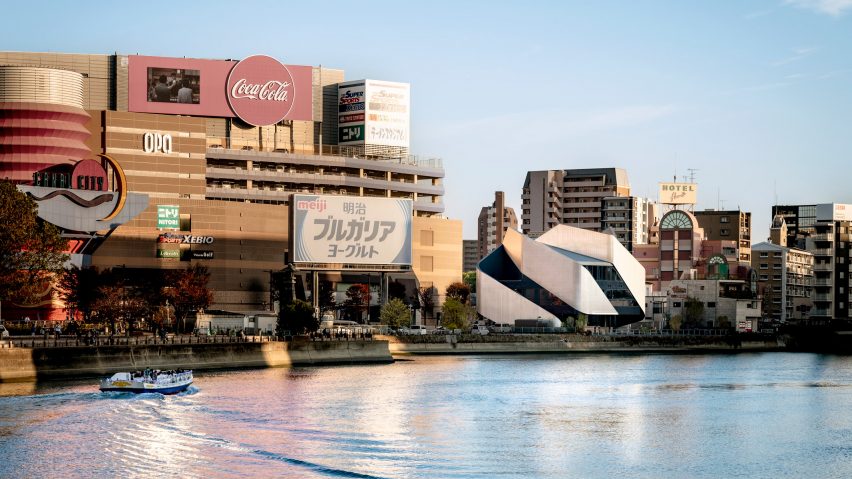In this week's comments update, readers are discussing Clouds AO's wrapped cultural hub in Japan and Reinier de Graaf's call for architects to stop using vacuous buzzwords.
A spiralling facade of stainless steel panels wraps around a new cultural centre in Fukuoka, Japan, designed by Clouds AO in collaboration with NKS2 Architects and Takumi Nakahara Architects (pictured above). Commenters debated the project's success.
"What value does the wrapping add?"
CrankFranky mused on whether the wrapping helps with solar shading, asking "what value does this wrapping add to the functionality of the building?"
Corbus Ghost thought the wrapping was only aesthetic, replying that it "makes the form dynamic and iconic, which suits a cultural building".
"When ya run out of ideas ... Wrap it!" quipped iDracula.
Marius was similarly dismissive, describing the wrapper as "naive or banal and meeting the ground awkwardly".
"There will be some head bumps caused by the edges coming down to the walkway at an angle", they cautioned.
Do you think the wrapped facade is a success? Join the discussion ›
"Architects do some excellent dancing"
Reinier de Graaf, partner at Dutch studio OMA, wrote an opinion piece for Dezeen this week about how "Listening to any contemporary conversation on architecture is like being indulged in a form of Orwellian Newspeak"
In the piece, De Graaf argued that architects must stop using the vacuous buzzwords that dominate the profession if they are to make a positive difference in the world. Dezeen readers waded into the comments section to debate the topic.
"The more architects are selling, the more generic the platitudes," commented JZ. "The more they are at liberty to offer candid takes, the more you will hear how the sausage gets made."
"And there's a lot of atmosphere between those extremes, where architects do some excellent dancing," they added.
Wyriwyg also acknowledged the challenges of communication, saying "the failure to speak to your audience without treating them as ignorant fools and also not speaking past them applies to many fields, not just architecture."
Tom Roberts contributed a potential aphorism, stating: "Buzzwords seldom translate to positive results."
But Harry Belafonte 3rd spiked the debate, arguing that "spin is good – after all, who wants to buy a loaf of bread when it could be sourdough?"
Meanwhile, Alfred Hitchcock was "surprised that OMA were making this complaint when their PR people might be one of the worst offenders."
What do you think about the use of buzzwords in architecture? Join the discussion ›
"The right scale for this typology"
International architecture studio SOM completed a terminal for Kansas City International Airport that features a large wood-clad canopy. Readers were generally delighted with the project.
"Very attractive and understated," commented Whateverandeveramen.
Ken agreed, saying "the use of natural materials creates a peaceful environment and this wood application is a very good choice for a busy public space".
"High impact and nicely lit. And, at the right scale for this typology," chipped in Franc Lea. "Which is not always the case."
But JB was less enthused: "It looks like an airport terminal. Well done."
Is the SOM-designed airport a high impact-building? Join the discussion ›
"There is a limit to renewable resource"
Sloppiness and misinformation are threatening to prevent large-scale wood construction from reaching its full potential, argued Hermann Kaufmann – the "grandfather of mass timber" – in an interview with Dezeen as part of our Timber Revolution series.
Pa Varreon commented: "There is an excessive use of wood and mass timber in these times. The fashionable abuse of it is perhaps one of the reasons, whatever the decarbonisation pretexts are, we will realise that the protection of forests is vital."
"Just look at the airport in Kansas City just published here. Was it really necessary to use wood ceiling and soffit there in such huge quantities? How many trees had to be felled to build that?" asked Apsco Radiales.
But Colin MacGillivray argued "if timber is farmed like pinus radiata in New Zealand, then every 25-30 years carbon is locked up in houses and a fresh crop is started. No shortage if done properly. Or bamboo (which is grass)."
"There is a limit to renewable resources; they need to be used in a reasonable quantity. The land loses nutrients and the land is limited, so overall, renewable doesn't mean unlimited in an X period," countered Jacopo.
What are your thoughts on building with timber? Join the discussion ›
Comments update
Dezeen is the world's most commented architecture and design magazine, receiving thousands of comments each month from readers. Keep up to date on the latest discussions on our comments page and subscribe to our weekly Debate newsletter, where we feature the best reader comments from stories in the last seven days.

